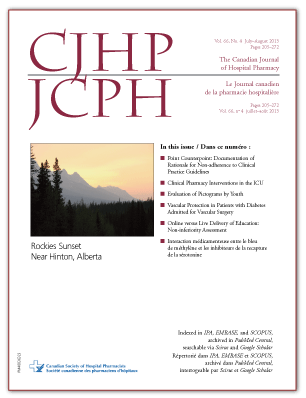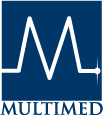Online versus Live Delivery of Education to Pharmacists in a Large Multicentre Health Region: A Non-inferiority Assessment of Learning Outcomes
DOI:
https://doi.org/10.4212/cjhp.v66i4.1271Keywords:
online learning module, web learning, applied skill teaching, pharmacist education, module d’apprentissage en ligne, apprentissage sur Internet, enseignement du savoir-faire, formation des pharmaciensAbstract
ABSTRACTBackground: The prevalence of online modules for continuing education in the health professions has been increasing in recent years. However, the effectiveness of online modules for pharmacist learning has not been thoroughly studied.
Objectives: The primary aim of this study was to determine if providing education to pharmacists through a self-paced enhanced online module was non-inferior to a face-to-face learning module with respect to knowledge application on the topic of postoperative insulin dosing. Secondary aims were to determine pharmacists’ knowledge gain and retention, as well as their satisfaction with the modules.
Methods: The participants in this prospective, randomized, parallelgroup non-inferiority trial were pharmacists in a large multicentre health region. Outcomes were measured by comparing scores obtained on pre- and post-module knowledge-assessment questionnaires. A betweengroup difference in change on knowledge application scores of less than 25 percentage points was the predetermined non-inferiority margin.
Results: A total of 74 pharmacists consented to participate, 38 randomly assigned to use the enhanced online module and 36 to attend the face-to-face learning session. For questions examining knowledge application, the mean improvement achieved by the online learning group was 26 percentage points greater than that achieved by the face-to-face learning group (95% confidence interval [CI] 25 to 27; p < 0.001). For questions testing knowledge gain, the improvement achieved by the online learning group was 7 percentage points less than that achieved by the face-to-face learning group (95% CI 2 to 12; p = 0.008). Therefore, the enhanced online module was deemed to be non-inferior to the face-to-face learning session in terms of knowledge application and knowledge gain. Insufficient data were available to analyze the secondary outcome of knowledge retention over time. Participant satisfaction was similar for the 2 groups (p = 0.62).
Conclusion: The self-paced enhanced online module was non-inferior to facilitated face-to-face learning in terms of improving application and knowledge of insulin dosing. Pharmacists had similar levels of satisfaction with the 2 modes of learning.
RÉSUMÉ
Contexte : La prévalence des modules d’apprentissage en ligne pour la formation continue des professionnels de la santé a augmenté ces dernières années. Cependant, l’efficacité de ces modules pour l’apprentissage des pharmaciens n’a pas fait l’objet d’études rigoureuses.
Objectifs : Le principal objectif de cette étude était de déterminer si la formation offerte aux pharmaciens au moyen d’un module d’autoapprentissage en ligne amélioré était non inférieure à un module d’apprentissage en personne pour ce qui est de l’application des connaissances sur le sujet de la détermination des doses d’insuline postopératoires. Les objectifs secondaires étaient de mesurer l’acquisition et la rétention des connaissances par les pharmaciens et leur satisfaction par rapport à l’apprentissage.
Méthodes : Les participants à cette étude prospective de non-infériorité à répartition aléatoire et groupes parallèles étaient des pharmaciens d’une importante régie régionale de la santé multicentre. Les résultats ont été mesurés en comparant les scores obtenus aux questionnaires d’évaluation des connaissances pré- et post-formation. Une différence intergroupe du changement des scores de l’application des connaissances de moins de 25 points de pourcentage constituait la marge de non-infériorité prédéterminée.
Résultats : En tout, 74 pharmaciens ont consenti à participer à l’étude, dont 38 ont été répartis de façon aléatoire dans le groupe module d’apprentissage en ligne amélioré et les 36 autres, dans le groupe séance d’apprentissage en personne. Pour les questions examinant l’application des connaissances, l’amélioration moyenne obtenue dans le groupe apprentissage en ligne était supérieure de 26 points de pourcentage à celle obtenue dans le groupe apprentissage en personne (intervalle de confiance [IC] à 95 %, 25 à 27; p < 0,001). Pour les questions testant l’acquisition de connaissances, l’amélioration obtenue dans le groupe apprentissage en ligne était inférieure de 7 points de pourcentage à celle obtenue dans le groupe apprentissage en personne (IC à 95 %, 2 à 12; p = 0,008). Par conséquent, le module d’apprentissage en ligne amélioré a été jugé non inférieur à la séance d’apprentissage en personne pour ce qui est de l’application des connaissances et de l’acquisition des connaissances. L’insuffisance des données n’a pas permis d’analyser le résultat secondaire relatif à la rétention des connaissances au fil du temps. La satisfaction des participants était similaire entre les deux groupes (p = 0,62).
Conclusion : Le module d’autoapprentissage en ligne amélioré était non inférieur à une séance d’apprentissage en personne au chapitre des connaissances et de leur application pour déterminer les doses d’insuline postopératoires. Les niveaux de satisfaction des pharmaciens étaient similaires entre les deux méthodes d’apprentissage.
Downloads
Published
Issue
Section
License
Copyright © Canadian Society of Healthcare-Systems Pharmacy.
After publication of a manuscript in the CJHP, the authors of the manuscript must obtain written permission from the CSHP (publications@cshp.ca) before reproducing any text, figures, tables, or illustrations from the work in future works of their own. If a submitted manuscript is declined for publication in the CJHP, all said rights shall revert to the authors. Please note that any forms (e.g., preprinted orders and patient intake forms) used by a specific hospital or other health care facility and included as illustrative material with a manuscript are exempt from this copyright transfer. The CJHP will require a letter from the hospital or health care facility granting permission to publish the document(s).










